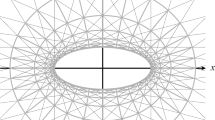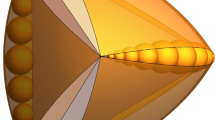Abstract
If one erects regular hexagons upon the sides of a triangle T, several surprising properties emerge, including: (i) the triangles which flank said hexagons have an isodynamic point common with T, (ii) the construction can be extended iteratively, forming an infinite grid of regular hexagons and flank triangles, (iii) a web of confocal parabolas with only three distinct foci interweaves the vertices of hexagons in the grid. Finally, (iv) said foci are the vertices of an equilateral triangle.





















Similar content being viewed by others
Notes
This pencil is known as the Schoutte pencil (Johnson 1917).
This is the double-length reflection about the barycenter \(X_2\).
References
Akopyan, A.: Private communication (2021)
Casey, J.: A Sequel to the First Six Books of the Elements of Euclid, 5th edn. Hodges, Figgis & Co., Dublin (1888)
Čerin, Z.: Regular hexagons associated to triangles with equal centroids. Elem. Math. 53, 112–118 (1998)
Čerin, Z.: Loci related to variable flanks. Forum Geometricorum 2, 105–113 (2002)
Dosa, T.: Some triangle centers associated with the excircles. Forum Geometricorum 7, 151–158 (2007)
Dragović, V., Radnović, M.: Bicentennial of the great Poncelet theorem (1813–2013): current advances. Bull. Amer. Math. Soc. (N.S.) 51(3), 373–445 (2014)
Fukuta, J.: Problem 10514. Am. Math. Mon. 103 (1996) (Solution: vol. 104 (1997), p. 775)
Fukuta, J.: Problem 1493. Math. Mag. 69 (1996) (Solution: 70 (1997), pp. 70–73)
Grinberg, D.: Private communication (2021)
Hoehn, L.: Extriangles and excevians. Math. Mag. 74, 384–388 (2001)
Johnson, R.: Directed angles and inversion with a proof of Schoute’s theorem. Am. Math. Mon. 24, 313–317 (1917)
Johnson, R.A.: Advanced Euclidean Geometry, 2nd edn. Dover, New York (1960). (Editor John W. Young)
Kimberling, C.: Encyclopedia of triangle centers. https://bit.ly/2GF4wmJ (2019). Accessed 16 June 2022
Lamoen, Fv.: Friendship among triangle centers. Forum Geometricorum 1, 1–6 (2001)
Martini, H.: On the theorem of Napoleon and related topics. Mathematische Semesterberichte 43, 47–64 (1996)
Morozov, E., Nilov, F.: Squares around affine regular and affine semi-regular polygons. Kvant. To appear (in Russian) (2022)
Reznik, D., Garcia, R.: Related by similarity II: Poncelet 3-periodics in the homothetic pair and the Brocard porism. Intl. J. Geom. 10(4), 18–31 (2021)
Stachel, H.: Napoleon’s theorem and generalizations through linear maps. Beiträge zur Algebra und Geometrie 43(2), 433–444 (2002)
Weisstein, E.W.: CRC Concise Encyclopedia of Mathematics, 2nd edn. Chapman and Hall, Boca Raton (2002)
Acknowledgements
We thank Arseniy Akopyan for contributing crucial insights and discovering the web of parabolas in the grid. Darij Grinberg lend us an attentive ear and proved the stationarity of \(X_{16}\). Clark Kimberling was kind enough to include our early observations on the Encyclopedia of Triangle Centers.
Author information
Authors and Affiliations
Corresponding author
Additional information
Publisher's Note
Springer Nature remains neutral with regard to jurisdictional claims in published maps and institutional affiliations.
Appendix A: Explicit formulas
Appendix A: Explicit formulas
To facilitate computational reproduction of our results, we provide code-friendly expressions for a few objects. In the expressions below a, b, c refer to sidelengths and x, y, z are barycentric coordinates.
1.1 A-parabola
It is given implicitly by:

The B- and C-parabolas can be obtained by cyclic permutations, i.e., \((a,b,c)\rightarrow (b,c,a)\), and \((a,b,c)\rightarrow (c,a,b)\), respectively.
1.2 The two “skip-1” parabolas
The skip-1 parabola through B is given by:

The skip-1 parabola through C is obtained with a bicentric substitution, i.e., \((a,b,c,x,y,z)\rightarrow (a,c,b,x,z,y)\).
1.3 Center (at infinity) of the A-parabola group
The A-parabola and BC skip-1 pair of parabolas have parallel axes through \(f_a,f_b,f_c\), therefore their axes will cross the line at infinity at the same point given by the following barycentrics;

1.4 Directrix of the A-parabola
Is is the line given by:

The other two directrices can be obtained via cyclic substitution.
1.5 Directrix equilateral
The barycentrics x, y, z of the A-vertex of the directrix equilateral (Proposition 12) are given by:

Rights and permissions
About this article
Cite this article
Moses, P., Reznik, D. A web of confocal parabolas in a grid of hexagons. Beitr Algebra Geom 64, 669–688 (2023). https://doi.org/10.1007/s13366-022-00651-1
Received:
Accepted:
Published:
Issue Date:
DOI: https://doi.org/10.1007/s13366-022-00651-1




